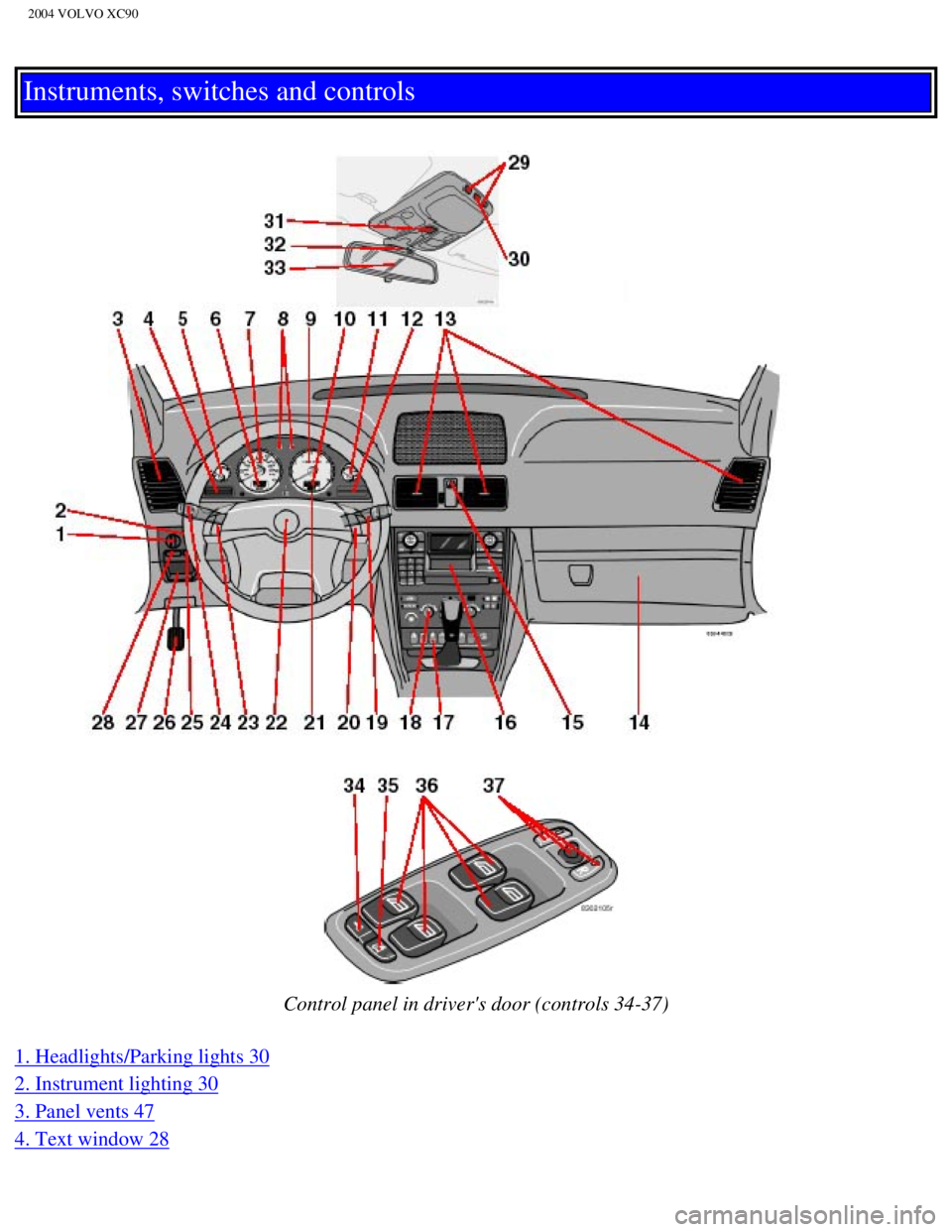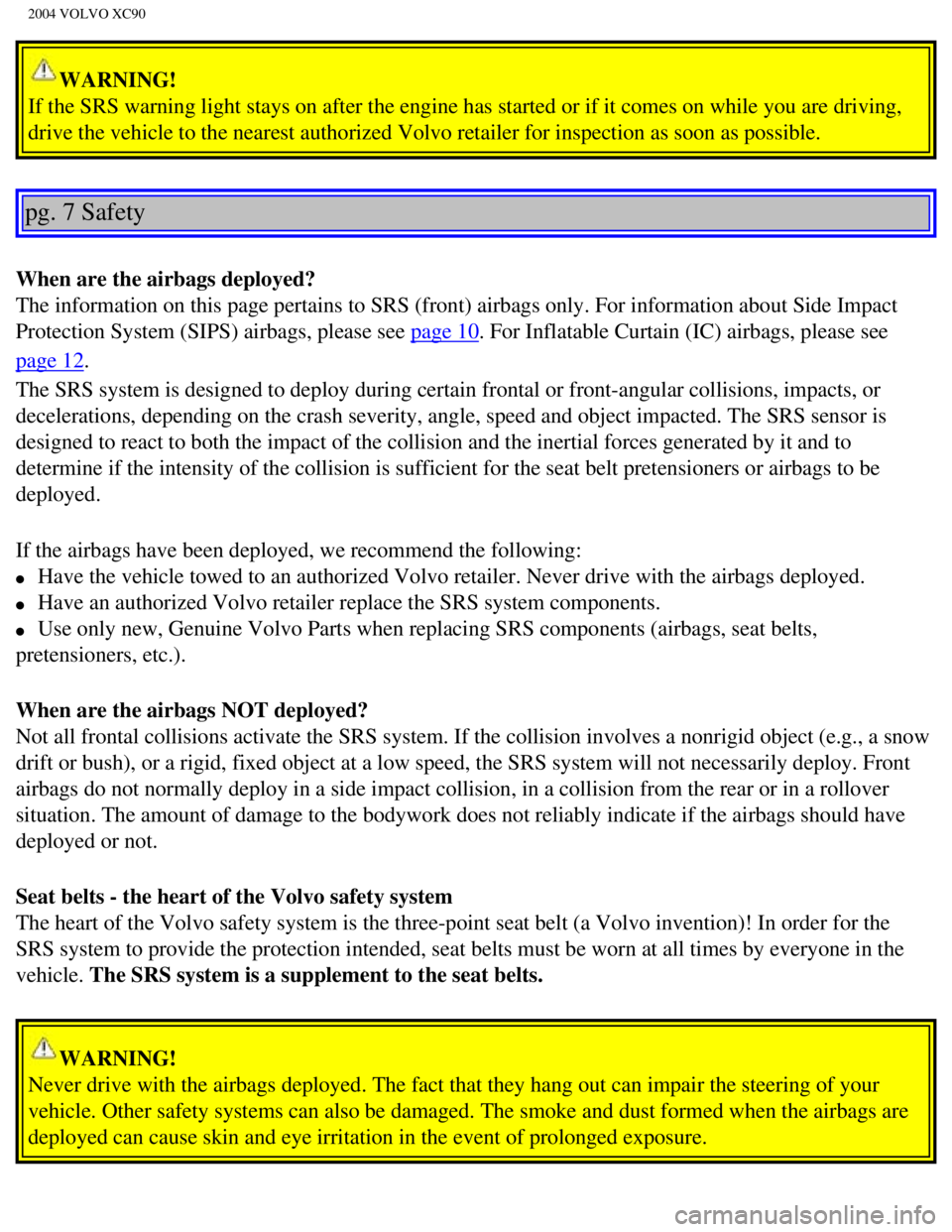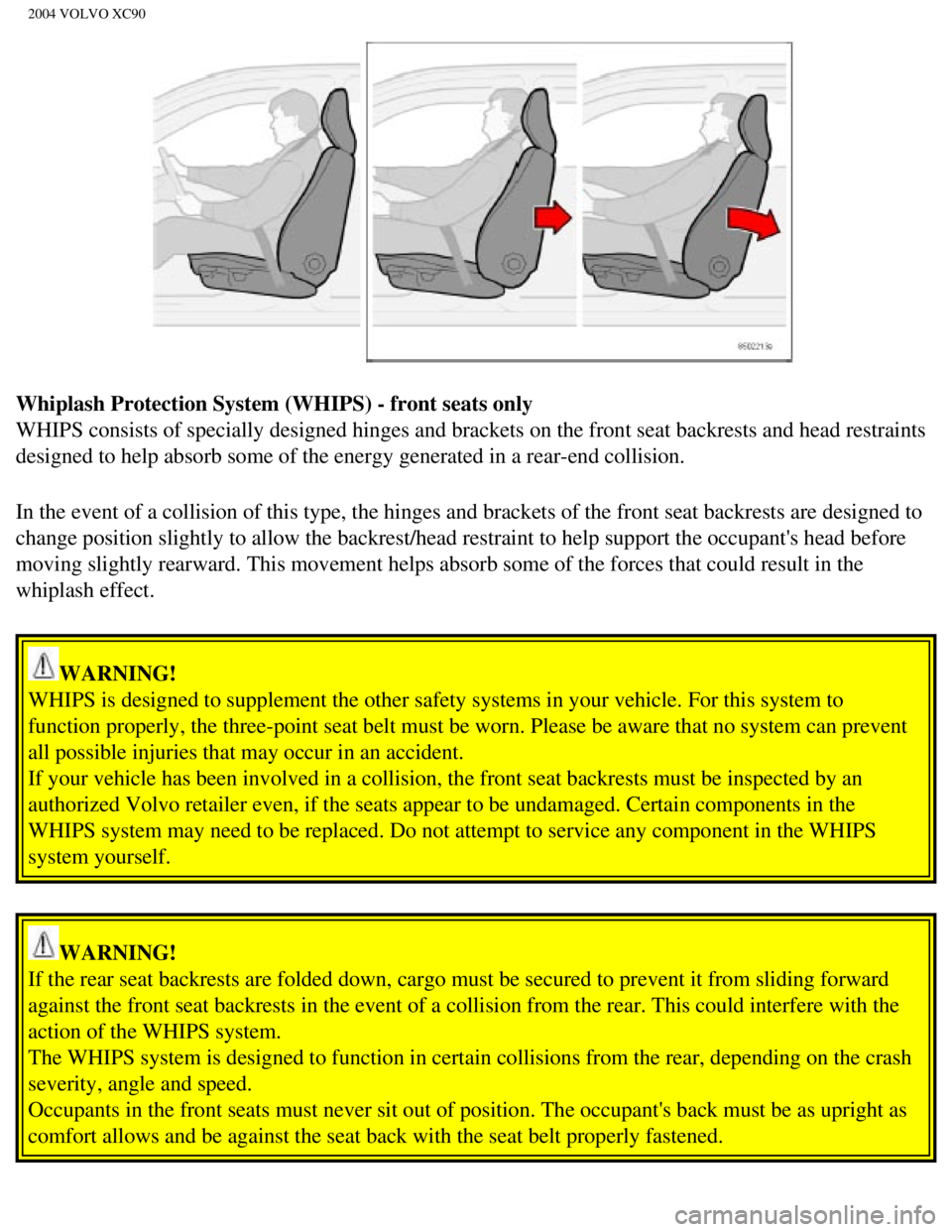2004 VOLVO XC90 light
[x] Cancel search: lightPage 2 of 245

2004 VOLVO XC90
instructions and maintenance requirements/recommendations in this manual\
. We also urge you and your
passengers to wear seat belts at all times in this (or any other) auto\
mobile. And, of course, please do not operate
a vehicle if you may be affected by alcohol, medication or any impairmen\
t that could hinder your ability to
drive.
Your Volvo is designed to meet all applicable safety and emission standa\
rds, as evidenced by the certification
labels attached to the driver's door opening and on the left wheel housi\
ng in the engine compartment.
For further information please contact your retailer, or:
In the USA:
Volvo Cars of North America
Customer Relations
P.O. Box 914
Rockleigh, New Jersey 07647-0914
800-458-1552
In Canada:
Volvo Cars of Canada Ltd.
175 Gordon Baker Road
North York, Ontario M2H 2N7
800-663-8255
General information
Shiftlock (automatic transmission)
When your car is parked, the gear selector is locked in the (P)ark position. To release the selector from this
position, turn the ignition key to position II (or start the engine), \
depress the brake pedal, press the button on the
front side of the gear selector knob and move the selector from (P)ark\
.
Keylock (automatic transmission)
When you switch off the ignition, the gear selector must be in the (P)ark position before the key can be
removed from the ignition switch.
Anti-lock Brake System (ABS)
The ABS system in your car performs a self-diagnostic test when the vehi\
cle first reaches the speed of
approximately 12 mph (20 km/h). The brake pedal will pulsate several t\
imes and a sound may be audible from
the ABS control module. This is normal.
Fuel filler door
The fuel filler door, located on the right rear fender, is connected to \
your vehicle's central locking system.
Press the button on the light switch panel (see
page 30) when the car is at a standstill to unlock the fuel filler
door. Please note that the fuel filler door will remain unlocked until t\
he car begins to move forward. An audible
click will be heard when the fuel filler door relocks.
Fuel filler cap
file:///K|/ownersdocs/2004/2004_XC90/04xc90_00.htm (2 of 7)12/30/2006 \
4:35:10 PM
Page 3 of 245

2004 VOLVO XC90
After refueling, close the fuel filler cap by turning it clockwise until\
it clicks into place. If this cap is not closed
tightly or if the engine is running when the car is refueled, the Malfun\
ction Indicator Lamp ("Check Engine"
light) may indicate a fault.
Important information
Before you operate your vehicle for the first time, please familiarize y\
ourself with the new engine oil
consumption information on
page 82. You should also be familiar with the information in chapters one, two \
and eight of this manual.
Information contained in the balance of the manual is extremely useful a\
nd should be read after operating the
vehicle for the first time.
The manual is structured so that it can be used for reference. For this \
reason, it should be kept in the vehicle for
ready access.
Do not export your Volvo to another country before investigating that co\
untry's applicable safety and exhaust
emission requirements. In some cases it may be difficult or impossible t\
o comply with these requirements.
Modifications to the emission control system(s) may render your Volvo \
not certifiable for legal operation in the
U.S., Canada and other countries.
All information, illustrations and specifications contained in this manu\
al are based on the latest product
information available at the time of publication. Please note that some \
vehicles may be equipped differently,
depending on special legal requirements. Optional equipment described in\
this manual may not be available in
all markets.
Volvo reserves the right to make model changes at any time, or to change\
specifications or design, without
notice and without incurring obligation.
CALIFORNIA Proposition 65 Warning
Engine exhaust, some of its constituents, and certain vehicle components\
contain or emit chemicals known
to the state of California to cause cancer, and birth defects or other r\
eproductive harm. In addition, certain
fluids contained in vehicles and certain products of component wear cont\
ain or emit chemicals known to the
State of California to cause cancer, and birth defects or other reproduc\
tive harm.
Volvo and the environment
Volvo is committed to the well being of our customers. As a natural part\
of this commitment, we care about the
environment in which we all live. Caring for the environment means an ev\
eryday involvement in reducing our
environmental impact.
Volvo's environmental activities are based on a holistic view, which mea\
ns we consider the overall
environmental impact of a product throughout its complete life cycle. In\
this context, design, production,
product use, and recycling are all important considerations.
file:///K|/ownersdocs/2004/2004_XC90/04xc90_00.htm (3 of 7)12/30/2006 \
4:35:10 PM
Page 5 of 245

2004 VOLVO XC90
Instruments, switches and controls
Control panel in driver's door (controls 34-37)
1. Headlights/Parking lights 30
2. Instrument lighting 30
3. Panel vents 47
4. Text window 28
file:///K|/ownersdocs/2004/2004_XC90/04xc90_00.htm (5 of 7)12/30/2006 \
4:35:10 PM
Page 6 of 245

2004 VOLVO XC90
5. Temperature gauge 24
6. Odometer/Trip odometer/Cruise control indicator 24, 37
7. Speedometer iv
8. Turn signal indicator lights 24
9. Tachometer 24
10. Ambient temperature gauge, clock, gear indicator 24
11. Fuel gauge 24
12. Indicator and warning symbols 25
13. Panel vents 47
14. Glove compartment 65
15. Hazard warning flashers 35
16. Audio system 159
17. Switches in the center console 29
18. Climate system controls 48
19. Windshield wiper/washer lever 33
20. Audio control buttons in steering wheel 161
21. Instrument panel 24
22. Horn iv
23. Cruise control buttons in steering wheel 37
24. Turn signals, High/low beams 32
25. Front fog lights, Rear fog light 30
26. Parking brake pedal 38
27. Parking brake release handle 38
28. Button for unlocking fuel filler door 30
29. Reading lights 61
30. Courtesy light 61
31. Moonroof control (option) 43
32. Seat belt reminder 27
33. Rearview mirror 42
34. Central locking button 75
35. Lockout switch for rear seat power windows 41
36. Power window controls 40
37. Sideview mirror controls 42
WARNING!
If your vehicle is involved in an accident, unseen damage may affect you\
r vehicle's driveability and
safety.
Contents
file:///K|/ownersdocs/2004/2004_XC90/04xc90_00.htm (6 of 7)12/30/2006 \
4:35:10 PM
Page 15 of 245

2004 VOLVO XC90
WARNING!
Children must never be allowed in the front passenger's seat. Volvo reco\
mmends that ALL occupants
(adults and children) shorter than 4 feet 7 inches (140 cm) be seate\
d in the back seat of any vehicle
with a front passenger-side airbag. See
page 20 for guidelines.
Occupants in the front passenger's seat must never sit on the edge of th\
e seat, sit leaning toward the
instrument panel or otherwise sit out of position. The occupant's back m\
ust be as upright as comfort
allows and be against the seat back with the seat belt properly fastened\
.
Feet must be on the floor, e.g. not on the dash, seat or out of the wind\
ow.
No objects or accessory equipment, e.g. dashboard covers, may be placed \
on, attached to, or installed
near the SRS hatch (the area above the glove compartment) or the area \
affected by airbag deployment
(see illustration on
page 4).
There should be no loose articles, e.g. coffee cups, on the floor, seat \
or dashboard area.
Never try to open the SRS cover on the steering wheel or the passenger s\
ide dash. This should only be
done by an authorized Volvo service technician.
Failure to follow these instructions can result in injury to the vehicle\
occupants.
Warning light in the instrument panel
A self-diagnostic system incorporated in the sensor monitors the SRS. Th\
is system does not, however,
monitor the Side Impact Protection System (SIPS) airbags. If a fault i\
s detected, the warning light will
illuminate. The light is included in the warning/indicator light cluster\
in the instrument panel. Normally,
the SRS warning lamp should light up when the ignition key is turned to \
positions I, II or III and should
go out after 7 seconds or when the engine is started. Check that this li\
ght is functioning properly every
time the vehicle is started.
The following items are monitored by the self-diagnostic system:
l Sensor unit
l Cable harness
l Gas generator
file:///K|/ownersdocs/2004/2004_XC90/04xc90_01a.htm (8 of 12)12/30/200\
6 4:35:11 PM
Page 16 of 245

2004 VOLVO XC90
WARNING!
If the SRS warning light stays on after the engine has started or if it \
comes on while you are driving,
drive the vehicle to the nearest authorized Volvo retailer for inspectio\
n as soon as possible.
pg. 7 Safety
When are the airbags deployed?
The information on this page pertains to SRS (front) airbags only. For\
information about Side Impact
Protection System (SIPS) airbags, please see
page 10. For Inflatable Curtain (IC) airbags, please see
page 12.
The SRS system is designed to deploy during certain frontal or front-ang\
ular collisions, impacts, or
decelerations, depending on the crash severity, angle, speed and object \
impacted. The SRS sensor is
designed to react to both the impact of the collision and the inertial f\
orces generated by it and to
determine if the intensity of the collision is sufficient for the seat b\
elt pretensioners or airbags to be
deployed.
If the airbags have been deployed, we recommend the following:
l Have the vehicle towed to an authorized Volvo retailer. Never drive with\
the airbags deployed.
l Have an authorized Volvo retailer replace the SRS system components.
l Use only new, Genuine Volvo Parts when replacing SRS components (airbag\
s, seat belts,
pretensioners, etc.).
When are the airbags NOT deployed?
Not all frontal collisions activate the SRS system. If the collision inv\
olves a nonrigid object (e.g., a snow
drift or bush), or a rigid, fixed object at a low speed, the SRS system\
will not necessarily deploy. Front
airbags do not normally deploy in a side impact collision, in a collisio\
n from the rear or in a rollover
situation. The amount of damage to the bodywork does not reliably indica\
te if the airbags should have
deployed or not.
Seat belts - the heart of the Volvo safety system
The heart of the Volvo safety system is the three-point seat belt (a Vo\
lvo invention)! In order for the
SRS system to provide the protection intended, seat belts must be worn a\
t all times by everyone in the
vehicle. The SRS system is a supplement to the seat belts.
WARNING!
Never drive with the airbags deployed. The fact that they hang out can i\
mpair the steering of your
vehicle. Other safety systems can also be damaged. The smoke and dust fo\
rmed when the airbags are
deployed can cause skin and eye irritation in the event of prolonged exp\
osure.
file:///K|/ownersdocs/2004/2004_XC90/04xc90_01a.htm (9 of 12)12/30/200\
6 4:35:11 PM
Page 26 of 245

2004 VOLVO XC90
Whiplash Protection System (WHIPS) - front seats only
WHIPS consists of specially designed hinges and brackets on the front se\
at backrests and head restraints
designed to help absorb some of the energy generated in a rear-end colli\
sion.
In the event of a collision of this type, the hinges and brackets of the\
front seat backrests are designed to
change position slightly to allow the backrest/head restraint to help su\
pport the occupant's head before
moving slightly rearward. This movement helps absorb some of the forces \
that could result in the
whiplash effect.
WARNING!
WHIPS is designed to supplement the other safety systems in your vehicle\
. For this system to
function properly, the three-point seat belt must be worn. Please be awa\
re that no system can prevent
all possible injuries that may occur in an accident.
If your vehicle has been involved in a collision, the front seat backres\
ts must be inspected by an
authorized Volvo retailer even, if the seats appear to be undamaged. Cer\
tain components in the
WHIPS system may need to be replaced. Do not attempt to service any comp\
onent in the WHIPS
system yourself.
WARNING!
If the rear seat backrests are folded down, cargo must be secured to pre\
vent it from sliding forward
against the front seat backrests in the event of a collision from the re\
ar. This could interfere with the
action of the WHIPS system.
The WHIPS system is designed to function in certain collisions from the \
rear, depending on the crash
severity, angle and speed.
Occupants in the front seats must never sit out of position. The occupan\
t's back must be as upright as
comfort allows and be against the seat back with the seat belt properly \
fastened.
file:///K|/ownersdocs/2004/2004_XC90/04xc90_01b.htm (7 of 16)12/30/200\
6 4:35:12 PM
Page 34 of 245

2004 VOLVO XC90
Occupant safety
How safely you drive doesn't depend on how old you are, but rather on:
l How well you see.
l Your ability to concentrate.
l How quickly you make decisions under stress to avoid an accident.
The tips listed below are suggestions to help you cope with the ever cha\
nging traffic environment.
l Never drink and drive.
l If you are taking any medication, consult your physician about its poten\
tial effects on your driving
abilities.
l Take a driver-retraining course.
l Have your eyes checked regularly.
l Keep your windshield and headlights clean.
l Replace wiper blades when they start to leave streaks.
l Take into account the traffic, road, and weather conditions, particularl\
y with regard to stopping
distance.
Reporting Safety Defects in the U.S.
If you believe that your vehicle has a defect which could cause a crash \
or could cause injury or death,
you should immediately inform the National Highway Traffic Safety Admini\
stration (NHTSA) in
addition to notifying Volvo Cars of North America. If NHTSA receives sim\
ilar complaints, it may open
an investigation, and if it finds that a safety defect exists in a group\
of vehicles, it may order a recall and
remedy campaign. However, NHTSA cannot become involved in individual pro\
blems between you,
your retailer, or Volvo Cars of North America. To contact NHTSA, you may\
either call the Auto Safety
Hotline toll-free at 1- 800-424-9393 (or 202-366-0123 in Washington, D.\
C. area) or write to: NHTSA, U.
S. Department of Transportation, Washington D.C. 20590. You can also obt\
ain other information about
motor vehicle safety from the Hotline.
Volvo strongly recommends that if your vehicle is covered under a servic\
e campaign, safety or emission
recall or similar action, it should be completed as soon as possible. Pl\
ease check with your local retailer
or Volvo Cars of North America, LLC if your vehicle is covered under the\
se conditions.
NHTSA can be reached at:
Internet:
http://www.nhtsa.dot.gov
Telephone:
1-888-DASH-2-DOT (1-888-327-4236) (toll free)
1-800-424-9393 (toll free)
1-202-366-0123 (in Washington DC area)
pg. 22 This page intentionally left blank.
file:///K|/ownersdocs/2004/2004_XC90/04xc90_01b.htm (15 of 16)12/30/20\
06 4:35:12 PM